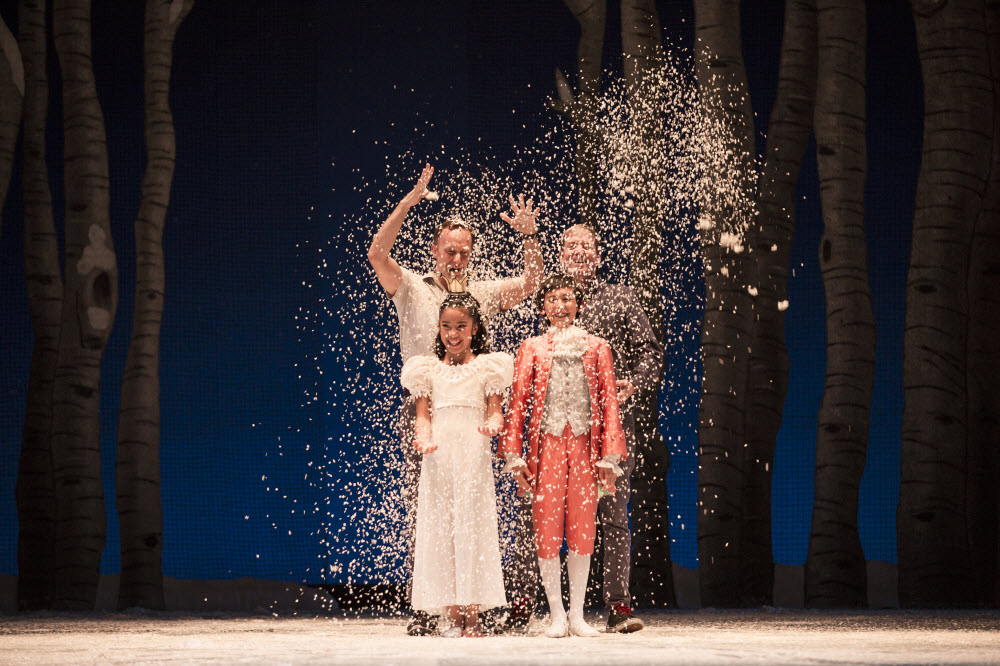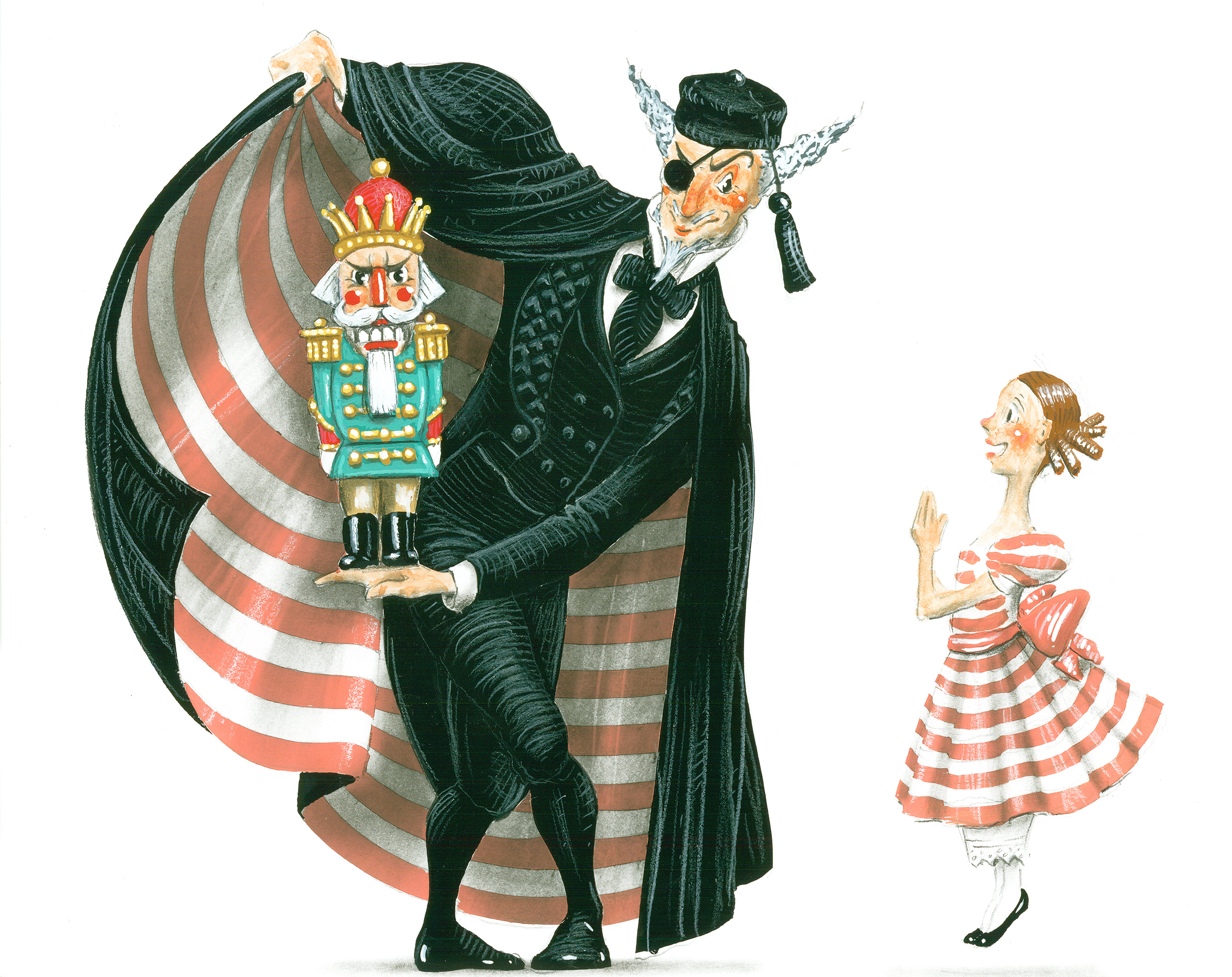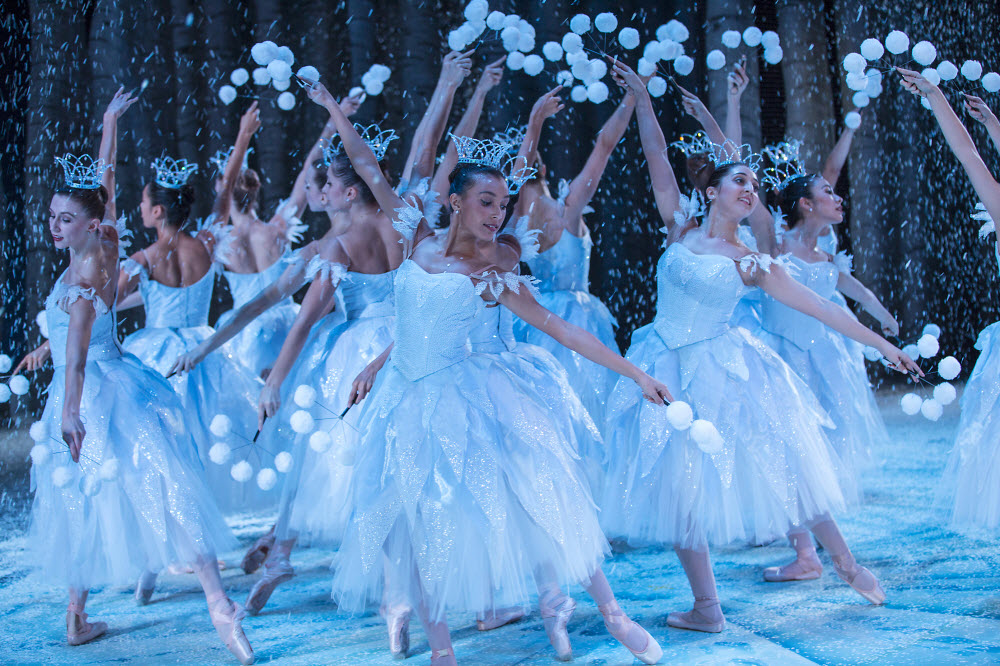
It's happening. After saying farewell to its beloved, homegrown Nutcracker production, with sets by Maurice Sendak and choreography by Kent Stowell, Pacific Northwest Ballet is debuting its new holiday production— George Balanchine's The Nutcracker — on Friday, Nov. 27.
While longtime fans of the Sendak-Stowell Nutcracker may feel like Christmas is cancelled, signs indicate that there are reasons aplenty to get excited about a new holiday tradition with choreography by George Balanchine and sets by children's illustrator Ian Falconer.
“There was a strong attachment to the Nutcracker that people in this area grew up with. That was a wonderful production,” says PNB artistic director Peter Boal. “[But] I think people will be surprised that there’s a lot that’s reassuringly the same [about the new production]. There’s a lot of consistency, and yet I think it’ll feel very fresh and very new.”
To help you adjust, here are 10 cool facts about PNB's new Nutcracker that tell the story of how the new production is unfolding.
1. George Balanchine’s The Nutcracker has a lot in common with the version that we know.
Both the Sendak-Stowell production and the Balanchine version are set to Tchaikovsky’s classic score and based on E.T.A. Hoffmann’s story of a little girl named Clara who receives a nutcracker doll from her Uncle Drosselmeyer at a Christmas party. Both productions have a party scene, a fight scene, and snowflake and flower petal dances. There is even a growing Christmas tree in both productions.
2. The Balanchine version is a celebration of childhood.
The biggest difference is the story in Act Two. Kent Stowell’s version is a coming-of-age story. In Act One, Clara is performed by a student dancer who is usually 12-14 years old. In Act Two, Clara grows up and travels to an exotic foreign land with her Nutcracker Prince, where they dance the grand pas de deux.
In Balanchine's ballet, a younger Clara and the Nutcracker Prince remain children throughout. They travel to The Land of Sweets, where they are entertained by personified candies and the grand pas de deux is danced by the Sugarplum Fairy and her Cavalier. The role of Clara went to Isabelle Rookstool, age 11, who has danced in the Stowell/Sendak Nutcracker three times and to Eden Anan, also 11, who has danced for four years, but is new to the PNB School this season.

3. Peter Boal danced the Nutcracker Prince in George Balanchine’s The Nutcracker when he was a boy.
PNB Artistic Director Peter Boal first performed in New York as the young Nutcracker Prince when he was 10 years old, so he knows well that this production means a significant new role for boys at PNB. “The little boy Prince has quite a bit. He’s secondary in the party scene, leading the battle scene and then he has this pantomime which is one of the longer solos in the ballet in Act Two,” Boal says. PNB’s inaugural Princes will be Ethan Arrington, who is 12 years old and joined PNB School this summer and Joh Morrill, who is 13 years old and has studied at PNB since 2014.
4. Balanchine’s The Nutcracker teaches children to dance like professionals.
“Balanchine really liked the children in his productions to be challenged technically," says Boal of the famous modern choreographer. "I think the choreography is particularly challenging for the eight tiny Polichinelles [little children or clowns who emerge during the Land of the Sweets]. "They have the same classical ballet exercises that I would give the Company dancers,” Boal says.
There are 140 students dancing 70 roles in Nutcracker in two separate casts that will divide the 36 performances. Most of the students attend three to five weekly rehearsals in addition to three regular classes. Because the choreography is new to almost everyone, children’s auditions were held in August to allow time for extra rehearsals. Ballet Master Otto Neubert explains some of the challenges for the young dancers. "They have to count a lot of things, not only the dance but the parts in between. They have to be attentive all the way through. For the boys more than ever they have to stay in line.”

5. It's still a local production.
PNB’s new production was built entirely by artisans, craftspeople, carpenters, painters and animators right here in Seattle. Sets and props were built in the ballet’s scene shop in Seattle’s Fremont neighborhood. Most of the costumes in the production were produced onsite at the ballet. Local artist Eric Andor’s team of fabricators built seventeen mice in his Pioneer Square studio. The Christmas Star is from the Chandelier series by Dale Chihuly.
6. The ballet starts with a movie.
The three-minute overture that begins the ballet is accompanied by a 3D animated film. “That’s a reaction to how I felt as a 5-year-old listening to the overture. I think parents of antsy children will be glad that there’s a film to draw them in to the story,” says Boal. Straightface Studios in Seattle’s Interbay neighborhood began production on the 3D animation in June. The finished film contains over 1.5 million trees; 8,540 bushes; 287 buildings and seven mice.

7. The sets will look familiar to fans of Olivia the Pig
New York-based Ian Falconer has designed sets for ballet before, as well as for opera and theater, but he is best known locally for the beloved Olivia picture books. After Falconer and Boal watched both the Balanchine and Stowell versions of the ballet together, Falconer dove into designing the new production with his familiar aesthetic: Bright colors and symmetrical patterns abound, especially Olivia’s own favorite red stripes. Within this bold, straightforward approach, Falconer has nestled some subtle nods to tradition, like a scrim depicting historical figures associated with the Nutcracker. Falconer has been praised by artisans in the PNB costume shop for being easy to work with, communicating a clear vision yet trusting others’ expertise in their craft.
8. The Nut Boat in George Balanchine’s The Nutcracker was modeled from a real walnut.
When Clara and the Nutcracker Prince sail off to the Land of Sweets, they will do so in a boat that shares its intricate wrinkles and coloration with a real walnut. Remarkable attention to detail runs through the entire production. The growing 40-foot-tall Christmas tree required 400 hours to build. Each of the 174 graduated velvet diamonds in the Harlequin costume is hand-sewn. When the costume shop couldn’t find striped fabric to meet design specifications, they hand-painted the stripes onto silk.

Pacific Northwest Ballet company dancers in the snow scene from George Balanchine’s The Nutcracker, choreography by George Balanchine. Photo © Angela Sterling.
9. More than 50 people worked on the costumes.
There are 154 costumes for the production, not counting duplicates for roles filled by different-sized dancers in the opposite cast. PNB’s costume shop wasn’t big enough to fit everyone, so production expanded to the shops at Seattle Children’s Theatre and Seattle Repertory Theatre. It’s no wonder they ran out of room – Mother Ginger’s skirt alone weighs 60 pounds, is ten feet wide and hides eight tiny dancers.
10. George Balanchine’s The Nutcracker will surprise you.
Even after more than 30 years of producing the Stowell/Sendak Nutcracker, there was still magic every night when the nutcracker’s jaws opened to reveal the stage. But there was very little uncertainty. “Putting it all together has been kind of thrilling,” Boal says, “and very new for us because we all knew the old one so well. Everybody’s coming at this one from scratch.”
If you go ...
When: George Balanchine’s The Nutcracker opens Friday, November 27 and runs through Sunday, Dec. 28. Show times are listed online. Arrive early to allow time for parking and pre-show activities. Performances run approximately two hours, including one intermission.
Activities and events: On opening weekend, special activities include crafts, carolers, magicians and dance classes. All special events, including some not listed here, can be found on the PNB web page. The Family Matinee Nutcracker Suite is $30/person. It includes a candy station; hot drinks; an appetizer buffet; alcoholic drinks for the adults and photo opportunities for kids during intermission. The Nutcracker Tea after the Dec. 5 matinee costs $65 adult/$45 child and includes a snacks-and-sweets buffet, autograph collecting opportunities and a keepsake poster.
Where: Marion Oliver McCaw Hall at Seattle Center, 321 Mercer Street. Booster seats can be borrowed at no cost and binoculars can be rented for $5. You can bring your own snacks for the intermission, but no food is allowed in the auditorium.
Tickets: Tickets range from $25 - $156 for adults/$22 - $141 for children 12 and under. Every family member must have a ticket. Tickets can be purchased online. The Teen Tix performance is Sunday, December 27, at 5:30 p.m.
Parking: The Mercer Garage ($15-$20) is connected to McCaw Hall by a sky bridge. Other pay lots in the neighborhood have similar pricing. Street parking is limited. Consider taking Uber or the bus — plan your route online. If you haven’t been to Seattle Center recently, be aware that Mercer and Roy streets have both been opened to two-way traffic.
Getting ready: Knowing what to expect can help younger viewers enjoy the show. Prepare by reading the ballet summary online as well as E.T.A. Hoffman’s original story, The Nutcracker and the Mouse King, or the Maurice Sendak-illustrated Nutcracker. (Falconer hasn’t written a Nutcracker picture book yet, but you can read Olivia Helps with Christmas.)
Age recommendations: Five years old is a traditional age for a child’s first Nutcracker, but any child who can stay engaged through a two-hour movie should be fine.
Preparing: Several recorded versions of the Nutcracker are available. Listen to recordings before you go or tune in to KING FM on December 5 at 7:30 p.m. to listen to a live broadcast of the score. For additional tips on attending the ballet with children, visit the PNB Kids web page.











